The following workflows guide you through the ArcGIS Server installation process on one machine. If you're installing ArcGIS Server on multiple machines, see the instructions in Install ArcGIS Server on multiple machines.
Note:
If you're upgrading to 11.3, see Frequently asked upgrading questions.
Prepare ArcGIS Server for installation
Follow these steps before beginning the installation process for ArcGIS Server:
- Obtain an authorization file for the machine on which you're installing ArcGIS Server.
- Verify that your site meets the system requirements.
For more information, see System requirements.
- Sign in as a user with administrative privileges.
- Close all applications on your computer.
- Browse to the folder containing the downloaded ArcGIS Server setup.
Note:
As of ArcGIS Enterprise 11.3, the ArcGIS Server self-extracting package consists of two files with .exe and .exe.001 extensions. To extract the package, ensure that both files are in the same folder.You're now ready to proceed with the ArcGIS Server installation.
Install ArcGIS Server
The instructions below describe how to install ArcGIS Server from the setup user interface.
Note:
You can download the setup files on the Downloads tab of your My Esri account.
- Browse to the location of the setup files and double-click Setup.exe.
- During the installation, read the master agreement and accept it, or close the window if you do not agree with the terms.
- The setup program displays the features that will be installed.
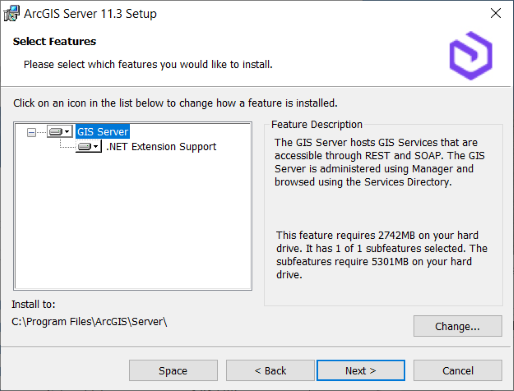
- GIS Server—Hosts GIS services that can be accessed through REST and SOAP. It is administered using ArcGIS Server Manager and its services are browsed through the Services Directory. This feature is required and includes support for publishing and hosting ArcGIS Pro-based services.
- .NET Extension Support—Supports the development and deployment of .NET server object extensions (SOEs) and server object interceptors (SOIs). This feature is optional. The appropriate version of Microsoft .NET is required for the .NET Extension Support feature to be displayed as a feature to be installed.
Note:
See the ArcGIS Server system requirements for the currently supported version of Microsoft .NET.
- Specify the account to be used by ArcGIS Server to perform a variety of functions.
You are presented with two options: Specify the account name and password and I have a configuration file with the account information generated by a previous run of this setup.
The first option, Specify the account name and password, allows you to directly specify the account name and password. The account can be a local account, domain account, or Managed Service Account. The account you specify does not have to be part of the Administrators group. If you use a Managed Service Account, the account must already be configured for your machine. If you use a local operating system account, the account is created if it does not already exist. The default account name is arcgis. For more information, see ArcGIS Server account.
Note:
For production systems, it's recommended that you use a preexisting account that resides in your domain or active directory and follows your organization's security policy. Creating a local account during the installation is primarily for the convenience of quickly installing ArcGIS Server.
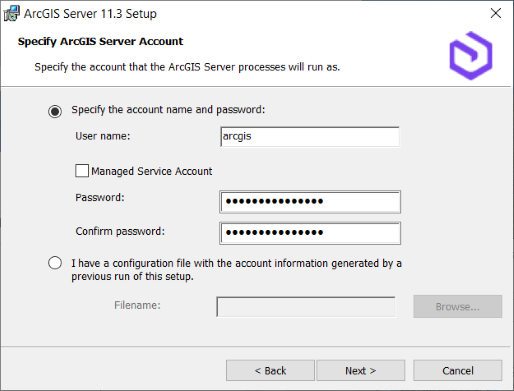
If you provide a domain account, it must already exist on the domain and must be entered using the following format:
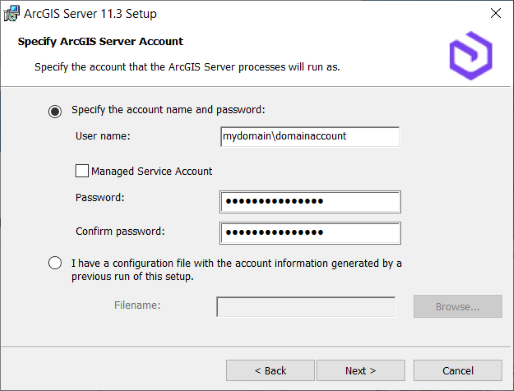
If you have a server configuration file generated by previously running the ArcGIS Server setup, choose the I have a configuration file option. Browse to the location of the server configuration file. The ArcGIS Server account is automatically configured with account information stored in the configuration file.
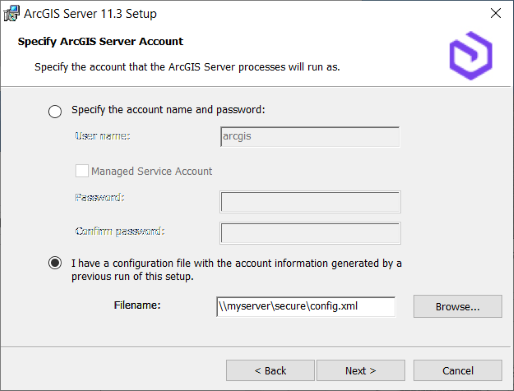
- If you chose Specify the account name and password and manually entered the ArcGIS Server account information, the next dialog box presents you with the option to export a server configuration file. If you do not want to export a configuration file, click Next and accept the default Do not export configuration file option. If you want to export a server configuration file for future installations, choose Export configuration file, browse to a secure folder, and enter a name for the configuration file.
The ArcGIS Server account information is exported to the specified server configuration file.
Note:
There are several reasons you may want to export a server configuration file, including the following:
- Create the same ArcGIS Server account when installing on multiple machines.
- Store the account for use when upgrading to a newer version.
- Perform a silent installation in which the username and password are encrypted.
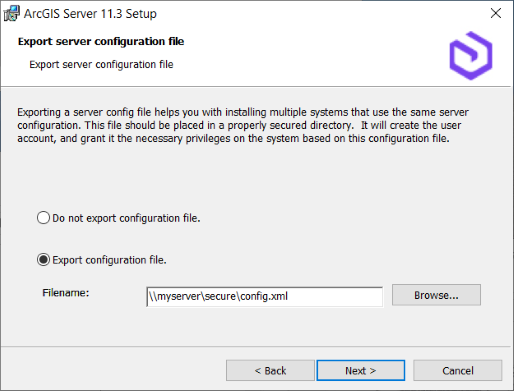
Caution:
When exporting a server configuration file to a network share, the Local System account on the machine where ArcGIS Server is being installed must have write permissions to the network share. For example, if you're installing ArcGIS Server on a machine named Quick, the Local System account on Quick must have write permission to the network share. If the permissions are not set, the server configuration file may not export successfully. If you are unsure how to correctly set permissions for the network share, contact your system administrator or export the server configuration file locally and copy it to the network share.
- Follow the directions on the screen to complete the installation.
After the installation completes, the Software Authorization Wizard window appears.
- Authorize the software.
For more information, see Authorize ArcGIS Server.
Note:
If the machine you've installed ArcGIS Server on has multiple network interface controller (NIC) cards or DNS entries, you may want to specify the NIC card that will handle network communication for the server. To do so, follow the Configure ArcGIS Server in advanced scenarios workflow.
After completing authorization, ArcGIS Server Manager should be open.
- Sign in to ArcGIS Server Manager and create a site.
For more information, see Create a site.
- If you're preparing your site for a production deployment, install ArcGIS Web Adaptor.
ArcGIS Web Adaptor provides a link between your enterprise web server and your ArcGIS Server site. It allows you to select the port, address, and authentication settings for incoming requests. It also prevents outside users from accessing Server Manager and the Administrator Directory. For more information, see Use ArcGIS Web Adaptor.
- Use the serverScan.py script to check for security best practices for your ArcGIS Server site following installation.
- Optionally, integrate your authorized and configured ArcGIS Server site with your ArcGIS Enterprise deployment.
A common, though not required, step is to federate an ArcGIS Server site with your ArcGIS Enterprise portal. Content shared to your portal is powered by services running on its federated ArcGIS Server sites.
Note:
ArcGIS Server sites that are not federated with an ArcGIS Enterprise portal are referred to as stand-alone sites.
Most of your work publishing services occurs in ArcGIS Pro. Users working in ArcGIS Pro can sign in to your ArcGIS Enterprise portal or connect directly to stand-alone ArcGIS Server sites. See Connect to ArcGIS Server from ArcGIS Pro for instructions.
- Ensure that ArcGIS Server can access all the data referenced by its services.
For more information, see Make data accessible to ArcGIS Server.
Your users can begin publishing and sharing content.
Note:
See Service publishing in ArcGIS Pro to learn more about the various publishing and sharing workflows available.